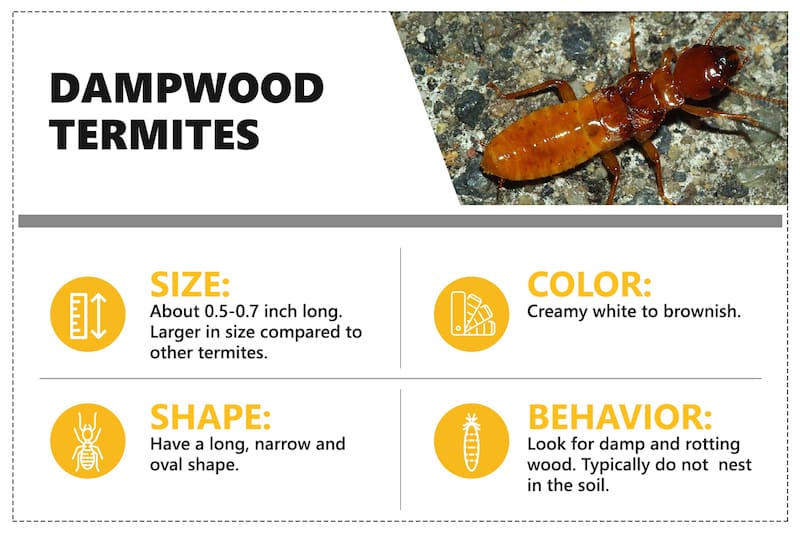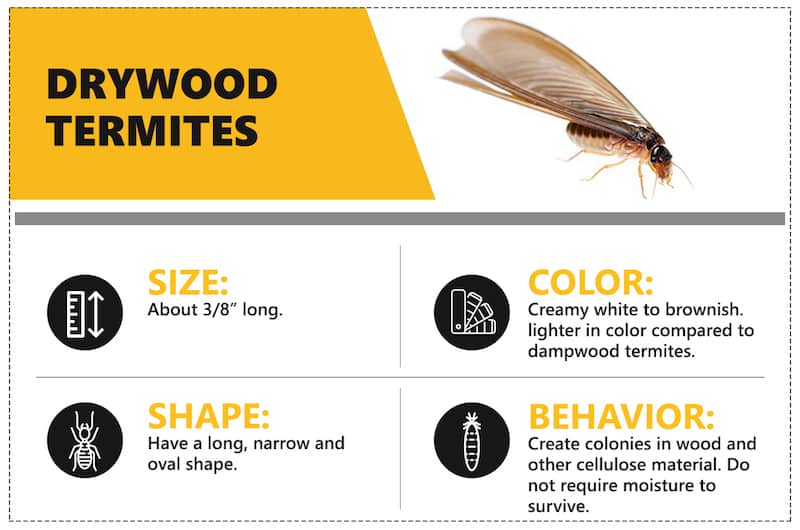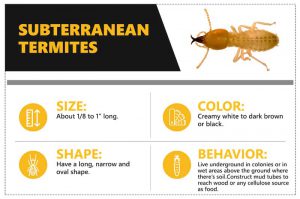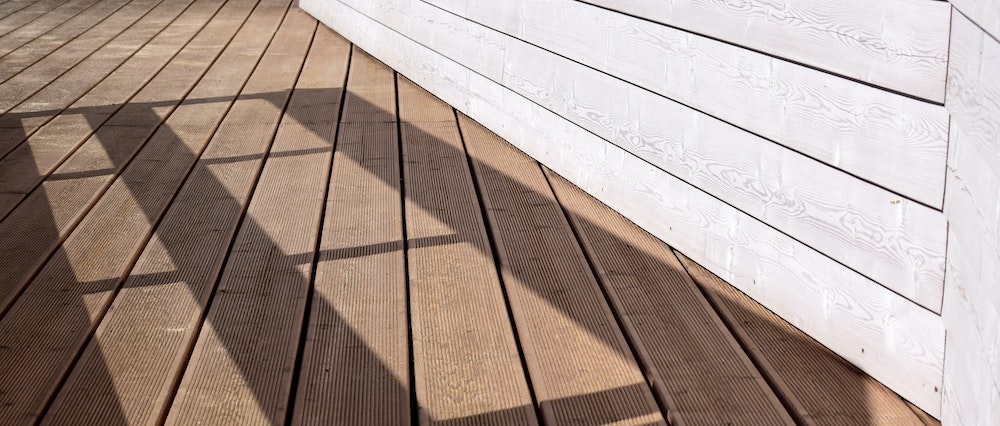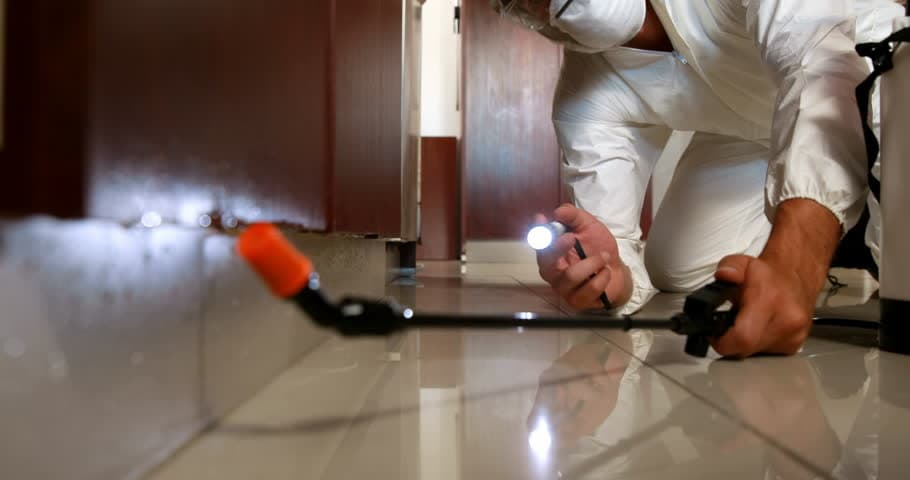What are Termites?
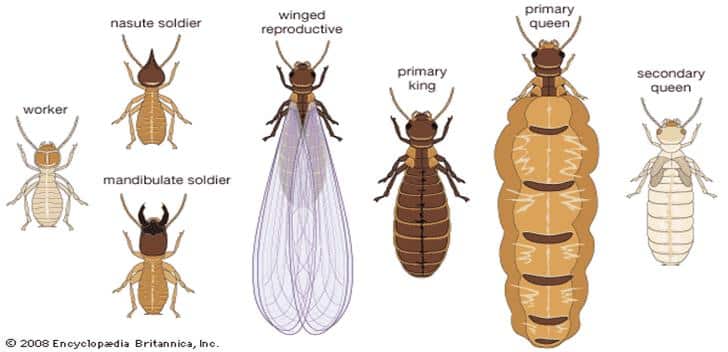
Image from Encyclopedia Britannica, Inc
Termites are little, pale soft-bodied insects that feed mostly on cellulose, a component of wood, but can destroy papers, textbooks, insulators, and more.
While termite workers only measure approximately 1 cm to a few millimetres in length, their feeding habits are capable of causing costly damage to property.
Why are Termites Harmful? How can Termites Destroy Homes?
Termites basically consume cellulose-based plant materials. Unfortunately, all homes can provide cellulose food for termite infestation. Though small, termites have the ability to damage properties such as house foundations, furniture shelves and even paper documents or books.
Termites have the nickname “silent destroyer” because they can be undetected yet thriving and breeding in your home without much signs of damage.
What do Termites eat?
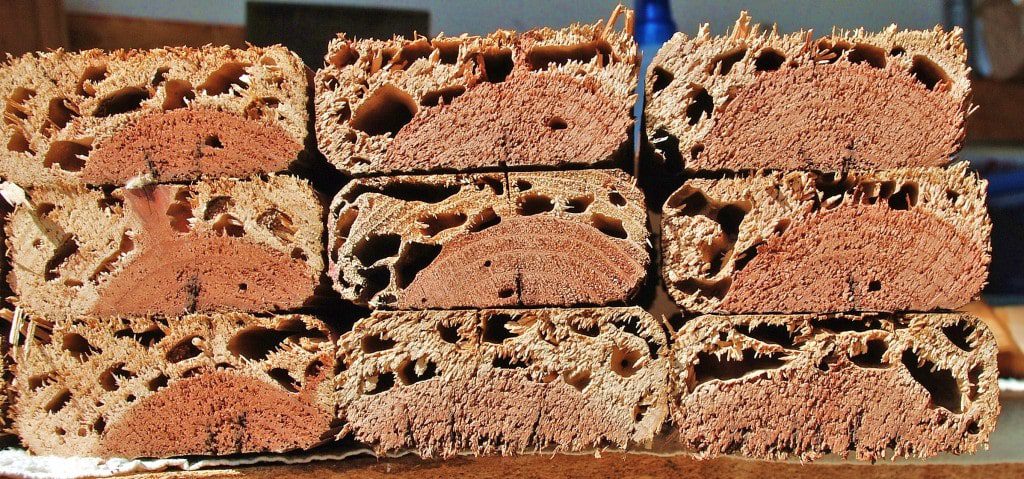
Image adapated from http://www.buenavistacompany.com/faqs/
Termites feed on many of these materials to get the cellulose to get their nutrients: plants, plant byproducts, cotton fibers (your t-shirt, for example), paper products and, of course, wood.
Not surprising, each species of termite has its own dietary preference.
- Softwoods are preferred by termites, who avoid the tougher summerwood. Subterranean termites consume wood that looks like a honeycomb, with dirt and faeces in many of the galleries.
- Dampwood termites generally stay close to the ground, but will choose moist, decaying wood anywhere it is found. Usually eats decaying tree stumps and logs. They rarely infest buildings.
- Drywood termites seek out dry wood such as the wood in your home’s framing, structural timbers, hardwood floors and furniture. They do not make contact with the soil and are able to glean the water they need directly from the wood they inhabit. When drywood termites are eating wood, the damage looks smooth.
pest control companies in Singapore
Why do Termites eat wood?
Termites eat wood to derive the cellulose and nutrients they need to live. Termites have protozoa and bacteria in their gut that allow them to break down the cellulose fibers in wood, which is difficult for other creatures to digest.
Types of Termites and How They Look like:
There are 3 main types of termites:
- Dampwood termites
- Drywood termites
- Subterranean termites
1. Dampwood Termites
Dampwood termites locate their colonies in damp, decaying wood, typically found in old trees, stumps and logs and known for attacking utility poles, pilings and fence posts.
How do Dampwood Termites look like?
There are different species of damp wood termites in Singapore. The termites are generally larger than subterranean termites.
- The swarmers can be up to 25 mm in length, including their wings and their soldiers being as large as 21 mm.
- Damp wood termites do have a large head with pincers on the front.
The behaviour of Dampwood termites:
- This species needs regular contact with water and high humidity to survive. This makes them very different compared to dry wood termites
- Dampwood termites do not create shelter tubes as compared to subterranean termites.
- Dampwood termites can live completely within the wood that they are eating.
- These termites plug openings into the wood they are infesting with faecal pellets to preserve humidity, and their cryptic behaviour can keep them from being discovered for years.
- Their intestines contain specialised microbes that aid in the digestion of wood. They feed on the contents of felled lumber, dead trees, and stumps.
Where are Damp wood Termites commonly found?
Dampwood termites are mostly found in woods that has high moisture content and wood or wood materials that are decaying.
However, these termites are seldom found in homes as the wood in homes do not have moisture content in it. They also do not require contact with the soil and are mostly found in damp woods.
2. Drywood termite
What how do Drywood Termites look like?
- Drywood termites are of different sizes depending on their caste. Soldiers are typically three-eighths of an inch long. Reproductives (both male and female) measure one-half of an inch in length.
- A drywood termite is usually pale brown, though it can vary between dark brown and light, yellowish-tan.
Behavior of Drywood termites:
- Drywood termites eat across the grain which destroys both the soft springwood growth and the harder summerwood growth.
- Most subterranean termites avoid the harder layers of wood, eating only the softer layers. Because they eat across the grain, the tunneling can lead to a building or tree collapsing if the colony’s network of tunnels grows too extensive.
- Drywood termites does not need moist soil or water nearby in order to thrive.
- Because they don’t need water, these termites are often found in dry wood above ground level.
- As with other species of termites, drywood termites are organized in a caste system.
Where are Dry wood Termites commonly found?
Drywood termites create colonies in wood, with no connection to the ground necessary. They are often found in attic wood and need very little moisture.
3. Subterranean termites
How Subterranean Termites look like?
Subterranean termites are can range from creamy white to dark brown and black depending on their caste. They may have rounded wing tips with all 4 wings being the same size. They have a thick waist, straight antennae and shorter legs.
Surprisingly, the size of subterranean termites changes according to on their caste. Workers range in length from one-eighth to three-eighths of an inch. Soldiers are as long as workers but have larger heads with powerful mandibles. Both supplementary and primary reproductives measure about 1 inch in length.
Behaviour of subterranean termites:
- There are three main types of subterranean termites – workers, soldiers and swarmers. Some termites have eyes while some do not.
- Worker termites live their entire lives in dark tunnels, both above and below ground. Though without eyes, they can still tell the difference between light and dark.
- Subterranean termites build shelter tubes or mud tubes to reach food sources and protect themselves from open air and to protect themselves against predators.
- Subterranean termites swarm in the spring when groups of reproductive termites go off to start new colonies.
- As their name indicates, subterranean termites live several feet below ground in bustling colonies.
Where are Subterranean Termites commonly found?
Subterranean nest in soil to get the moisture, but may also nest in wood that are damp. The best method of subterranean termite control is to avoid water accumulation near your home’s foundation. Reduce humidity in crawl spaces with proper ventilation.
Most importantly, eliminate wood contact with the soil. You can view more in our article about preventive measures against termites.
The Life Cycle of Termites
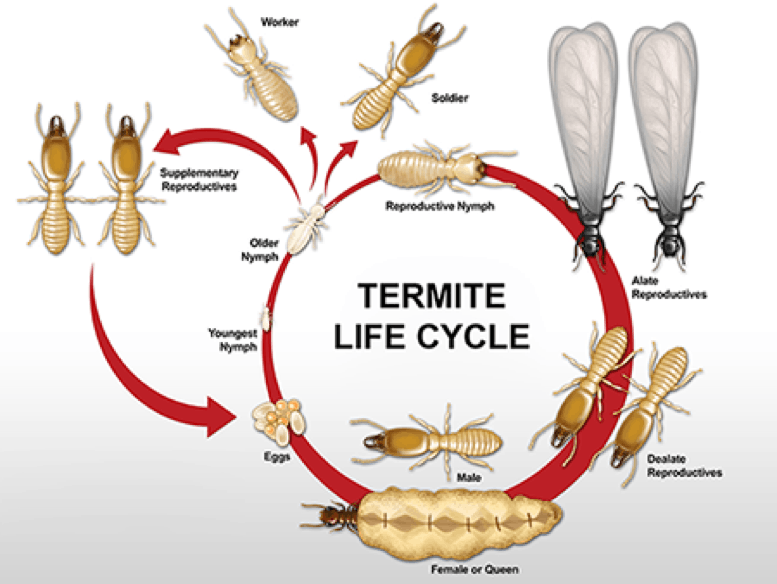
1. Mating Flight
The lifecycle of the termite begins with a mating flight where reproductive males and females leave their colonies and procreate.
After fertilisation, winged termites shed their wings and proceed to form new colonies. These insects then become the king or queen termites of their newly established colonies. The queen and king termites are at the centre of the termite life cycle and are responsible for reproduction.
2. Eggs
The fertilised queen will lay her eggs, after which pale white larvae will hatch from the eggs.
3. Molting
Eggs hatch into larvae will develop into workers, soldiers, primary reproductives and secondary reproductives.
The termite growth process begins with a process called molting. First, a termite develops a soft exoskeleton under its current, hard exoskeleton. Then, once the termite has reached maturity, its outermost skeleton splits open, and the new exoskeleton enlarges and hardens.
This moulting process continues throughout a termite’s life cycle based on the colony’s needs.
4. Larvae
Interestingly, termites in colonies live in a caste system. Over the course of several molts, these larvae grow to assume a role in one of the three termite colony castes: workers, soldiers and reproductive termites (also known as alates).
5. Castes
Each caste has a different physical appearance, so termites from the same colony have different physical appearance and sizes depending on their roles in the colony.
In fact, research has indicated that castes in the termite life cycle are not rigidly set, as termites belonging to one caste may develop into another caste if the colony requires it. Thus, a soldier termite may become a worker or a reproductive termite if the colony experiences a shortage of one or the other.
6. Termite Life Cycle: Reaching Maturity and Swarming
Swarming is a part of the termite life cycle. When reproductives reach full maturity and are capable of reproducing, they gain wings and eyes. To assist the swarming termites to tolerate exposures to sunlight and less humid air, their bodies, now known as alates, become tougher and darker.
7. Life Span
Workers and soldiers live approximately one to two years. Queen termites may survive for over a decade under optimal climate conditions.
Termite Warning Signs
You have previously mentioned about 8 tell-tale signs of termite infestation, here is a brief summary of 5 of the most common signs:
1. Wood damage
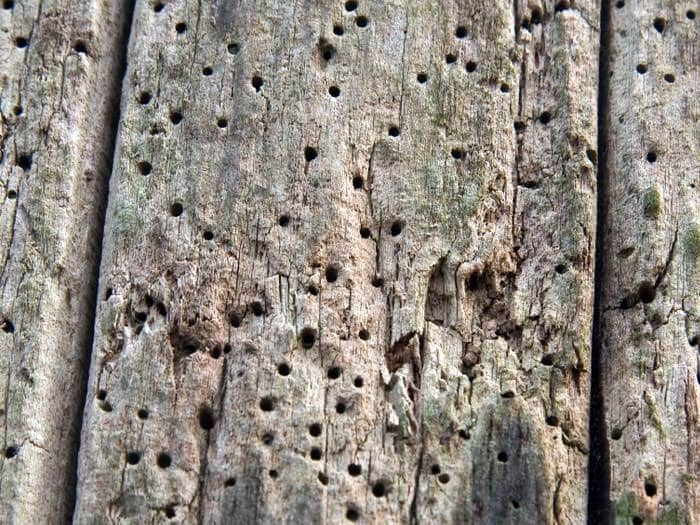
Though termites consume cellulose-based plant materials (like papers, even drywalls), their diet is mainly consuming wood (like furniture). Wood damage on your furniture or cellulose-based items at home is tell-tale sign that termites are infesting your home.
There are differences in the appearance of damage caused by different termites. For dry wood termites, typically leave piles of wood powder or pellets where they burrow. They can also cause wood to take on a blistered appearance by tunnelling too close to the surface. You can read more about dry wood termites in our previous article.
Moisture-damaged wood is most susceptible to damp wood termite infestation. Wood infested by damp wood termites generally shows no external damage because openings in the wood are plugged with faecal material. You can find out more about damp wood termites from our previous article.
A quick exercise you can do is to check for the hollowness of your wood-based items/furniture at home. Woods are not hollow until it is eaten up from inside. Termite damaged wood sounds hollow when tapped.
Find A Termite Control Company
2. Discarded Wings
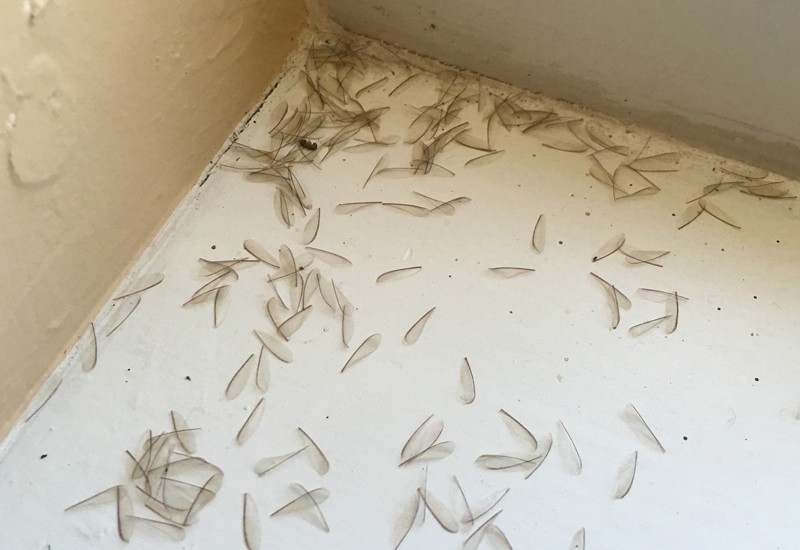
Termite colonies’ reproductive members, or swarmers, may take flight in large groups to look for new places to start breeding. Usually, these swarmers will cast off their wings after finding the right place to dig through the wood.
Usually, you can spot cast-off termite wings around doors or window grills as these are entry points for lights and they are drawn to light.
3. Mud or shelter tubes
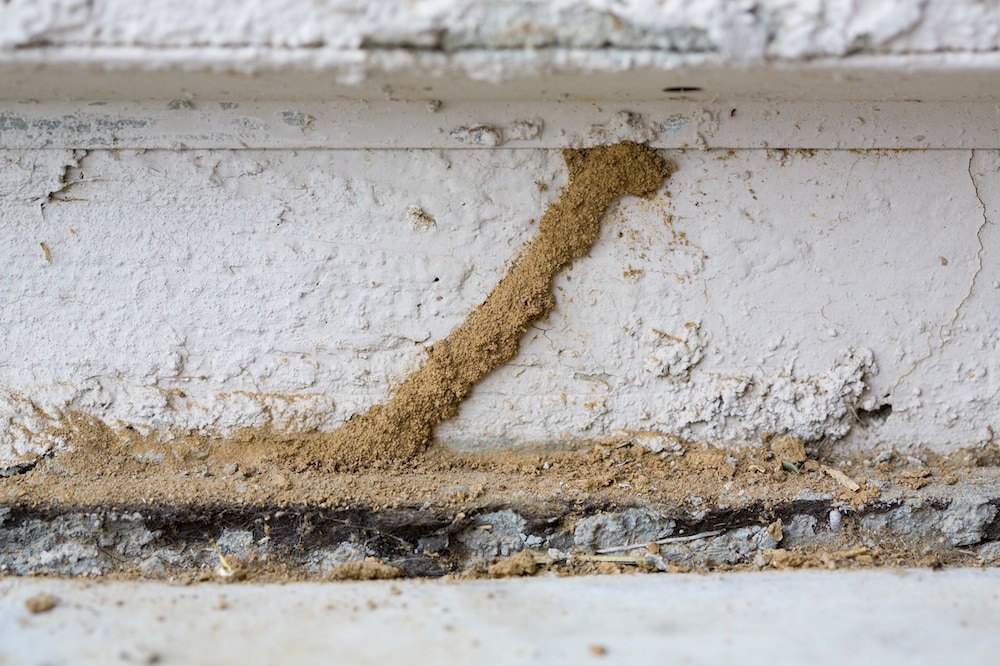
Termites may also build shelter tubes (also known as mud tubes) made out of the dirt of wood particles cemented together by their saliva and other fluids. The purpose of these tubes is to ensure the temperature and moisture content is right for them to thrive and breed.
These tubes are usually about the width of a pencil and are brown. These mud tubes are commonly found on walls, cracks, and attics, and may run along flat surfaces or hang down vertically.
To check for active termites in these tubes, scrape off a piece of the mud tube. If termites crawl out or repair the tunnel or build a new one, an active colony is present.
4. Subterranean tunnels
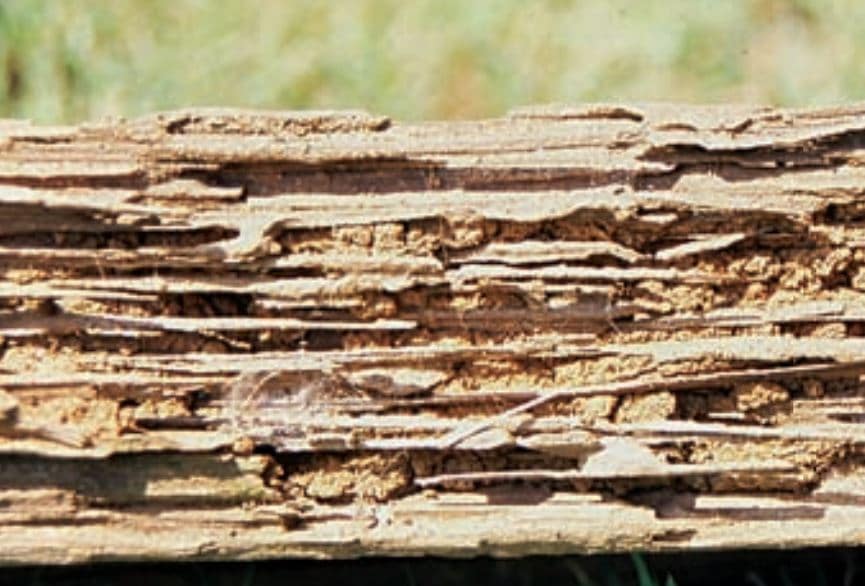
Subterranean termites like dark and moist spaces, hence they are usually hiding in the soil or travelling through these tunnels. Wood that looks fine on the outside may be riddled with tunnels on the inside. To check if an area is infested, tap or probe it with a screwdriver. Severely damaged timber sounds hollow and is easy to pierce.
Since they like living and travelling through moist soil, untreated or moist wood that touches the earth is most likely to be affected.
5. Brown Pellets of Excrement
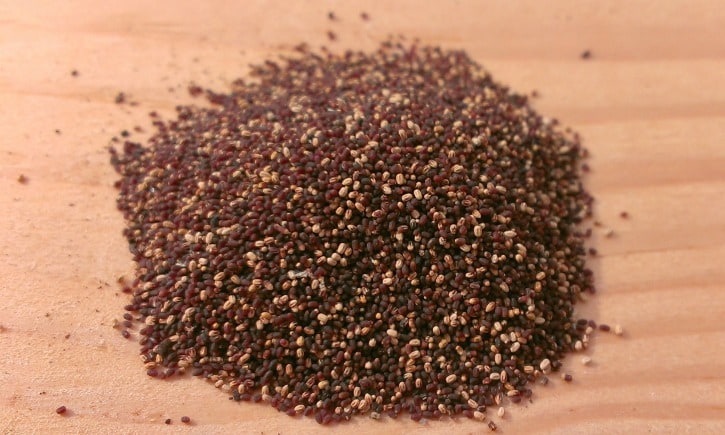
Also known as frass, termite droppings are ridged and small. They are usually dark brown and appear to be wood-coloured pellets. Typically, these faeces are near the openings of mud tubes, where they have eaten or nested.
Note that only certain species of termites will leave faeces behind. If more faecal pellets appear over time, this is a sure sign of infestation.
6. Termite Tapping Noises
When termites travel through the wood, they create tapping noises for various reasons. One, soldier termites knock their heads against the wall then they sense danger so as to warn others of imminent danger.
Two, worker termites may emit clicking sounds with their mouths as they work their way through the wood.
Hence, if you hear knocking, clicking or paper rustling sounds, your wood could potentially be infested with termites.
Here is what a termite sounds like:
7. Uneven or Bubbling Paint
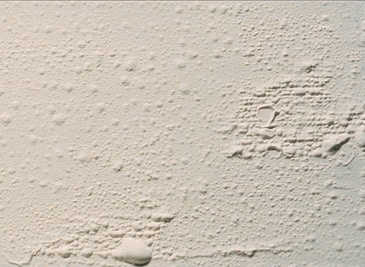
Uneven or bubbling paint could be a sign of termites infestation. It could also be due to water build-up, caused by plumbing or water damage.
When termites tunnel through wood, the paint could sometimes be separated from the wood. This causes uneven and bubbling paint as air bubbles form between paint and wood.
8. Hollow Sounding Wood
Because termites work their way through the wood, hollow wood will have resulted. Tapping on the wood will thus result in hollow sounds.
If you hear such sounds when tapping, it is time to call the pest control company. It means that the colony is not small, and it cannot be easily handled by yourself.
How Do You Get A Termite Infestation?
1. Moisture
Subterranean termites, which build their colonies in the soil, are attracted to moisture. Still, water in or around the home’s foundation creates an attractive environment for these termites.
This opens up a multitude of factors that can cause termites infestation. Leaky pipes, clogged roof gutters and drainage can create an attractive, moist environment for the termites.
2. Wood and wooden structure that comes into contact with your home
Termites primarily feed on cellulose, an essential component of wood. Any wood-like materials in contact with your home’s exterior serve as a point of entry for termites.
3. Openings in your home foundation, roofs or walls
Termites will take advantage of any breach in your home’s integrity in the search for moisture and food.
Cracks in home foundation offer opportunities for subterranean termites to gather materials for the construction of their mud tubes, the tunnels by which they travel in their foraging.
Prevention Tips
After examining what may cause termite infestations, we take a look at the preventive measure we can take to eliminate these infestations:
1. Eliminate moisture problems
After examining what may cause termite infestations, we take a look at the preventive measure we can take to eliminate these infestations:
- Fix leaky faucets, water pipes and aircon units.
- Keeping gutters and drainage systems unclogged
- Remove excessive plant cover and wood mulch
- Getting rid of still water, especially open drains and on roofs
- Keep all vents clear and open
- Seal entry points around water and utility lines or pipes
2. Removing contact between wood materials and home exterior
Periodically check and remove any stumps, vines, mulch, trellises or other exterior wood that is close to your home. If you stay in a landed property, note that your roof may be vulnerable to termite infestation.
Here are a few actions you can take to further trim down the chances of termite infestations:
- Trim back any tree limbs that are resting on your roof or touching wooden structures such as eaves or window framing.
- Get rid of stumps and debris near the house
- Check decks and wooden fences for damage
- Wood on your home shouldn’t contact the soil
3. Periodic monitoring, checking for activities
Since termite damages may be hard to detect (or even notice at all), periodic monitoring reduces the chances of termite infestations. It allows you to take action before the infestation worsens. Below are a few things you can do for periodic monitoring:
- Do periodic checks on the entry points to your home (windows, doors), as well as look for any loose or defective seals where electrical conduit or plumbing lines enter your home.
- Ensure that simple problems such as leaky pipes and cracks in the wall are dealt with quickly to prevent termite build-up.
- Inspect the wood in your home and check for hollowness
- Monitoring stations — ask a pest management professional to recommend prevention techniques around your home, which could include monitoring stations, liquid treatment or direct wood treatment. Monitoring stations are the least intrusive option since they serve as warning signs of activity; however, they do not provide any protection against infestations. Proactive treatment can help protect your home against future infestations.
- You can schedule periodic maintenance with a professional termite control company to protect your home against these termite infestations.
Prevention Tips To Protect Your Home
1. Eliminate moisture problems
After examining what may cause termite infestations, we take a look at the preventive measure we can take to eliminate these infestations:
- Fix leaky faucets, water pipes and aircon units.
- Keeping gutters and drainage system unclogged
- Remove excessive plant cover and wood mulch
- Getting rid of still water, especially open drains and on roofs
- Keep all vents clear and open
- Seal entry points around water and utility lines or pipes
2. Removing contact between wood materials and home exterior
Periodically check and remove any stumps, vines, mulch, trellises or other exterior wood that is close to your home. If you stay in a landed property, note that your roof may be vulnerable to termite infestation.
Here are a few actions you can take to further trim down the chances of termite infestations:
- Trim back any tree limbs that are resting on your roof or touching wooden structures such as eaves or window framing.
- Get rid of stumps and debris near the house
- Check decks and wooden fences for damage
- Wood on your home shouldn’t contact the soil
3. Periodic monitoring, checking for activities
Since termite damages may be hard to detect (or even notice at all), periodic monitoring reduces the chances of termite infestations. It allows you to take action before the infestation worsens. Below are a few things you can do for periodic monitoring:
- Do periodic checks on the entry points to your home (windows, doors), as well as look for any loose or defective seals where electrical conduit or plumbing lines enter your home.
- Ensure that simple problems such as leaky pipes and cracks in the wall are dealt with quickly to prevent termite build-up.
- Inspect the wood in your home and check for hollowness
- Monitoring stations — ask a pest management professional to recommend prevention techniques around your home, which could include monitoring stations, liquid treatment or direct wood treatment. Monitoring stations are the least intrusive option since they serve as warning signs of activity; however, they do not provide any protection against infestations. Proactive treatment can help protect your home against future infestations.
- You can schedule periodic maintenance with a professional termite control company to protect your home against these termite infestations.
How To Avoid Infestation In The First Place
1. Keep Their Food Away
Without a doubt, the best way to keep termites away is to leave them without food. As you may know, their primary food source is anything that contains cellulose. That’s why you should remove any stacks of firewood from your home. Also, make sure you clean up your basement.
Overall, you should keep wood sealed and away from the insect’s reach. If you can’t avoid using firewood, keep it on an elevated platform. Usually, you’d want it to be at least twenty centimetres off the ground. The procedure includes about fifteen centimetres away from the nearest wall or object.
2. Trim the Trees and Bushes
Another crucial part of keeping termites away from your home is the surroundings. Indeed, the trees and bushes around your house can be the perfect hideout of termites. Some species may find shelter in live trees like Drywood and Dampwood. Besides, untrimmed trees and bushes are always a harborage for various insects and rodents.
That’s why you should do yourself a favour and trim your garden regularly. That way you’ll make your property look clean. What’s more, you’ll eliminate the danger of falling branches during inclement weather.
3. Make Sure You Eliminate the Wet Spots
Apart from cellulose, termites love moisture. So, they can quickly find harbours in areas where water tends to sit for long without drainage. Therefore, you should take note of the gutters, drainage canals, and any water damage on your ceiling and walls.
In some cases, even leaks on your air conditioning system and pipes can attract termites. Also, be careful of pipe bursts during winter. If you want to make sure termites don’t come back, perform regular checks inside and outside your house. Always avoid direct water dripping to the ground. If possible, connect it to your drainage system.
4. Maintain Proper Ventilation
Along with ensuring your house area has proper drainage, you’ll have to ensure there’s adequate ventilation, too. Maintaining adequate airflow will eliminate excess moisture. Moreover, it will allow sunlight – a valuable amenity for every home.
If you plan on installing an aircon unit in your house, make sure you choose its location wisely. Generally, it shouldn’t blow air directly into a wooden beam or foundation. Otherwise, you risk causing moisture accumulation inside.
If you’ve already made a mistake, you should call for a water damage remediation service. Typically, those experts will use special dehumidifiers and dryers to take the excess moisture out of the affected areas.
Find storage space companies in Singapore
5. Be Careful with Your Mulch
If you’re a home gardener, then you’ll have to take extra precautions when mulching. Indeed, gardens are giant termite attracting magnets, so it’s best to place your mulch as far away as possible. As you may know, mulch is rich in food and moisture – just what termites love!
Also, it’s a good idea to minimize your mulch, so it doesn’t become a delicious target for the little pests. Of course, you don’t have to get rid of it all. Instead, you can avoid overwatering it and dumping leftovers.
Besides, you can use redwood or cypress chips because termites don’t like their scent and natural content. But don’t think they will save you from the pests. They’re only less attractive.
6. Be Wary of Old Furniture
Perhaps, you may love antique furniture. Of course, it will bring much-needed warmth to your home. However, they can also bring uninvited guests. As you can imagine, wooden furniture can be the perfect vehicle for termites. Once they reach your home, they will soon start expanding their territory.
In case you get a piece of furniture from a neighbourhood mired with termites, make sure you clean it thoroughly. Usually, you’d want to let it aerate under direct sunlight as much as possible. Also, you can use termite sprays to ensure no mites or bugs are hiding inside.
7. Keep Your Roof Clean
As we speak about moisture, the roof can be one of the problematic areas in your house. Unfortunately, many homeowners forget about the attic until it’s too late. Of course, most termites will harbour on the ground, but some species can crawl into your roof. There, they may use the accumulated moisture from your blocked gutter.
Also, they can use holes in the roof as entry points. Therefore, it’s essential to keep your roof and gutters in perfect condition. That way you’ll prevent leaks and bug infestations.
8. Perform Regular Checks
No matter how good you are at spotting termites, you can never trust your bare eyes entirely. Instead, you should call professional termite control companies for annual termite checks.
Perhaps, you’ll find it surprising how effective such checks can be. These experts use special tools to detect moisture levels inside your walls and floors. Moreover, they will do their best to identify potential infestations even in their initial stages.
Besides, many pest control companies offer termite bonds that serve as insurance coverage. Those contracts include regular inspections and treatment procedures in case of possible infestations.
Of course, some extra fees may apply. However, it’s much better to pay a small fee for regular checks and treatment. Otherwise, you risk the integrity of your house. In the worst scenarios, this mistake may cost you thousands of dollars.
9. Apply Safe Termiticide Sprays
After you eliminate the termite infestation, your best shot would be to do your best not to let them in again. Perhaps, one of the effective ways to avoid mite infestation is to apply termiticide sprays. Typically, these products act as a barrier against those pests. When using them, make sure you wear protective gear and ensure adequate ventilation.
10. Keep an Eye on Your Attic and Basement
As previously mentioned, your roof can become an attractive place for pesky mites. After all, they love dark, moist, and undisturbed areas. For this reason, you’d want to keep an eye on your attic and basement.
Since they’re the ideal spot for a termite infestation, you wouldn’t want to keep stashing piles of newspaper and old boxes. Otherwise, you’re just helping the monster in your basement grow.
In turn, you should clean up and remove any clutter, so you don’t give any hints to the pests. What’s more, you’ll be able to spot their presence earlier. Don’t forget to do the same for all the undisturbed parts of your home.
Find termite control services on Homees
DIY termite control methods
We strongly encourage you to seek professional help if your home is infested with termites. However, there are preventive measures you can take to reduce the chances of termite infestations.
Here are ten tips to protect your greatest investment from termites:
- Eliminate or reduce moisture in and around the home. Most termites like living in a dark and moist environment – reducing these areas in your home reduce the chances of them breeding.
- Repair leaking faucets, water pipes and exterior air-con units.
- Repair fascia, soffits and rotted roof shingles.
- Replace weather-stripping and loose mortar around the basement foundation and windows.
- Divert water away from the house through properly functioning downspouts, gutters and drainage system.
- Have a periodic inspection of your home for signs of mud tubes, uneven or bubbling paint and wood that sounds hollow when tapped.
- Monitor all exterior areas of wood, including windows, doorframes and skirting boards for any noticeable changes. You can view here for visible signs of termite damage.
- Maintain a 20-30cm gap between soil and any wood portions of your home.
- Scheduling a professional termite inspection annually. Wood-boring insect damage is not covered by homeowners’ insurance policies.
- Keep external wood/wood-material items away as far away from home.
Termites cannot be controlled with do-it-yourself measures. If you suspect a termite infestation, contact a licensed pest professional immediately to determine the extent of the problem and receive a recommendation of an appropriate course of treatment.
Find Reliable Pest Control Companies in Singapore
In addition, to protect your home from termites and other pests, you can connect with top-rated insect screen companies through Homees.
Homees provides a list of reliable pest control companies in Singapore. Pest control companies typically deal with the following infestations:
- insects: ants, bed bugs, termites, wasps, fleas, lizards, cockroaches
- rodents: mice, rats
If you are looking for pest control professionals to match your personalised requirements, you can contact Homees HomeMatch for a more quick and fuss-free experience.
You can find out more information from NEA’s website on engaging pest control operators: https://www.nea.gov.sg/our-services/pest-control/pest-control-operators.
You can also find out a list of vectors, which are organisms that transmits diseases, from NEA’s site: https://www.nea.gov.sg/our-services/pest-control/overview.
Related Articles
We’re here to improve your home
Speak to hundreds of reliable pros, view their gallery, inspirations, and know the best prices with our resources.
Have full control over your home improvement projects with Homees.


